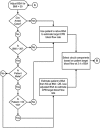Lean Flow: Optimizing Cardiopulmonary Bypass Equipment and Flow for Obese Patients-A Technique Article
- PMID: 28298663
- PMCID: PMC5347216
Lean Flow: Optimizing Cardiopulmonary Bypass Equipment and Flow for Obese Patients-A Technique Article
Abstract
The goal of this chart review was to investigate the use of down-sized cardiopulmonary bypass (CPB) circuits for obese patients. The effects of transitioning from larger to smaller oxygenators, reservoirs, and arteriovenous tubing loops were evaluated through a retrospective review of 2,816 adult non-congenital procedure perfusion records. This technique report and case series is a continuation of our original prescriptive CPB circuit quality improvement project. An algorithm was derived to adjust body surface area (BSA) to lower body mass index (BMI) to provide down-sized extracorporeal circuit components capable of meeting the metabolic needs of the patient. As a result of using smaller circuits, decreased priming volumes led to significantly increased hemoglobin (HB) nadirs (p < .05) leading to significant decreases in homologous donor blood product exposures (p < .05). Patients with large BSAs were supported safely with smaller circuits by using lean body mass (LBM)-adjusted BSA and target blood flow algorithm. Based on this case series, large BMI patients may be safely supported with smaller circuits selected based on BSAs adjusted more toward LBM. Use of smaller circuits in high BMI patients led to higher HB nadirs and less donor blood components during the surgical procedure. Renal function and hospital stay were not affected by this approach.
Figures


Similar articles
-
Prescriptive patient extracorporeal circuit and oxygenator sizing reduces hemodilution and allogeneic blood product transfusion during adult cardiac surgery.J Extra Corpor Technol. 2013 Sep;45(3):167-72. J Extra Corpor Technol. 2013. PMID: 24303598 Free PMC article.
-
Evaluation of different diameter arterial tubing and arterial cannulae in simulated neonatal/pediatric cardiopulmonary bypass circuits.Artif Organs. 2015 Jan;39(1):43-52. doi: 10.1111/aor.12446. Artif Organs. 2015. PMID: 25626579
-
MAST system: a new condensed cardiopulmonary bypass circuit for adult cardiac surgery.Perfusion. 2001 Nov;16(6):447-52. doi: 10.1177/026765910101600603. Perfusion. 2001. PMID: 11761083
-
Optimal perfusion during cardiopulmonary bypass: an evidence-based approach.Anesth Analg. 2009 May;108(5):1394-417. doi: 10.1213/ane.0b013e3181875e2e. Anesth Analg. 2009. PMID: 19372313 Review.
-
Prebypass filtration of cardiopulmonary bypass circuits: an outdated technique?Perfusion. 2003 Mar;18 Suppl 1:81-8. doi: 10.1191/0267659103pf632oa. Perfusion. 2003. PMID: 12708770 Review.
Cited by
-
2024 EACTS/EACTAIC/EBCP Guidelines on cardiopulmonary bypass in adult cardiac surgery.Br J Anaesth. 2025 Apr;134(4):917-1008. doi: 10.1016/j.bja.2025.01.015. Epub 2025 Feb 14. Br J Anaesth. 2025. PMID: 39955230 Free PMC article.
-
Is there really a benefit of using minimized cardiopulmonary bypass in CABG? A retrospective propensity score-matched study with 5000 cases.Heart Vessels. 2020 Jan;35(1):14-21. doi: 10.1007/s00380-019-01458-2. Epub 2019 Jun 24. Heart Vessels. 2020. PMID: 31236675
-
Implementation of a Prescriptive Extracorporeal Circuit and Its Effect on Hemodilution and Blood Product Usage during Cardiac Surgery.J Extra Corpor Technol. 2020 Dec;52(4):295-302. doi: 10.1182/ject-2000037. J Extra Corpor Technol. 2020. PMID: 33343032 Free PMC article.
-
2019 EACTS/EACTA/EBCP guidelines on cardiopulmonary bypass in adult cardiac surgery.Interact Cardiovasc Thorac Surg. 2020 Feb 1;30(2):161-202. doi: 10.1093/icvts/ivz251. Interact Cardiovasc Thorac Surg. 2020. PMID: 31576402 Free PMC article. No abstract available.
-
2024 EACTS/EACTAIC/EBCP Guidelines on cardiopulmonary bypass in adult cardiac surgery.Interdiscip Cardiovasc Thorac Surg. 2025 Feb 5;40(2):ivaf002. doi: 10.1093/icvts/ivaf002. Interdiscip Cardiovasc Thorac Surg. 2025. PMID: 39949317 Free PMC article. No abstract available.
References
-
- Ferraris V. A., Brown J. R., Despotis G. J., et al. . 2011 update to the society of thoracic surgeons and the society of cardiovascular anesthesiologists blood conservation clinical practice guidelines. Ann Thorac Surg. 2011;91:944–82. - PubMed
-
- Gallagher M. J., Franklin B. A., Ehrman J. K., et al. . Comparative impact of morbid obesity vs heart failure on cardiorespiratory fitness. Chest. 2005;127:2197–203. - PubMed
-
- Santambrogio L., Leva C., Musazzi G., et al. . Determination of pump flow rate during cardiopulmonary bypass in obese patients avoiding hemodilution. J Card Surg. 2009;24:245–9. - PubMed
-
- Alston R. P., Anderson A., Sanger K.. Is body surface area still the best way to determine pump flow rate during cardiopulmonary bypass? Perfusion. 2006;21:139–47. - PubMed
MeSH terms
LinkOut - more resources
Full Text Sources
Medical
Research Materials
